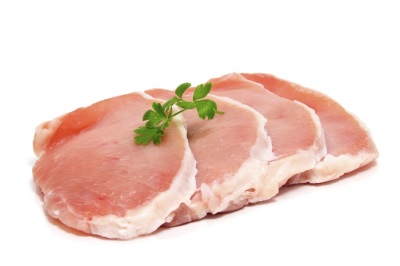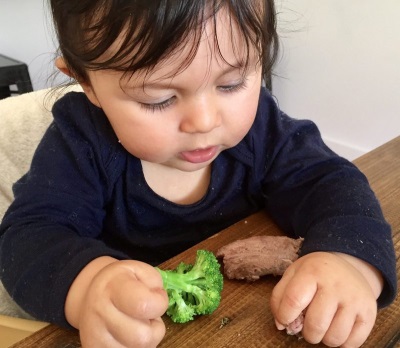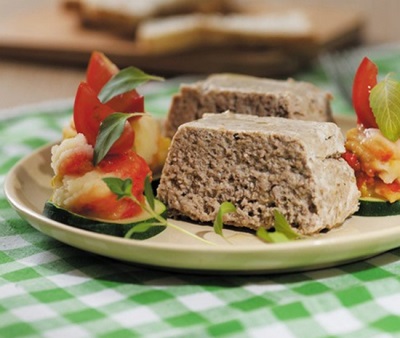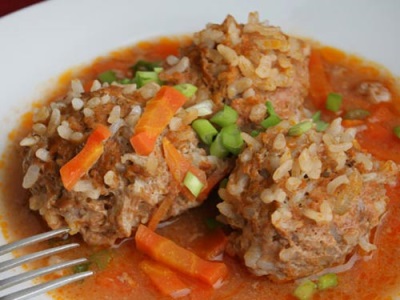At what age can pork be given to a child and which dishes are best to cook?
After becoming acquainted with vegetable dishes, cereals and fruit, it is time to incorporate meat into the children's diet. It is recommended to begin meat lure with rabbit or turkey. But is it possible to give kids pork?
This type of meat is considered by many moms too fat and hard to digest. Nevertheless, it can be introduced into the child’s diet, if you know when to start feeding pork, how much to cook such meat and what to cook from it for the children's menu.
Benefit
- From lean pork, the baby will get healthy proteins, in which there are all the necessary children for the full growth of amino acids.
- Pork is the source of all the B vitamins. These compounds are important for the development of the nervous system, immune function, prevention of anemia and other processes in the children's body.
- Among the minerals that are rich in pork, especially a lot of magnesium, potassium, copper and calcium. Due to this composition, the consumption of pork meat has a positive effect on intellectual activity, the work of the heart, the state of bones and blood formation.
- Since pork has a lot of iron, iodine, zinc and arachidonic acid, This product is useful for stress and stimulates regeneration processes.
- Among the fats that are present in pork, especially a lot of oleic and linoleic acids, which are important for the normal functioning of the child's body and are part of the cell membrane.
- Eating pork stimulates muscle growth, Therefore, this type of meat is recommended for children who attend sports clubs and experience significant physical exertion.
- Dishes from pork will help to diversify the diet of the child with milk intolerance (it provokes intolerance to beef), as well as allergies to chicken.
Differences from other types of meat
Pork is digested no worse than any other meat and has a pleasant taste.
It also features the following features:
- Pork contains more vitamins belonging to group B than beef.
- Pork tenderloin contains more protein than chicken, beef and turkey.
- Due to the lower content of connective tissue, this type of meat is cooked faster, and cooked or stewed pork is easier to chew.
- Thanks to fatty layers when baking, pork meat remains juicy.
Hurt pork
Some children are allergic to swine meat. This is one of the main reasons why you can not start meat lure with such a product, and to introduce pork in the children's menu should be very careful.
Especially often provokes an allergic reaction fatty pork, so for baby food use only lean parts.
Also remember that fried pork dishes are contraindicated for children up to 3 years old. In the menu of young children can not include kebabs and other unnecessarily fatty dishes from such meat. Failure to follow these recommendations can lead to problems in the digestive tract and other ailments.
From what age to give
Nowadays, doctors, among whom is Dr. Komarovsky, do not recommend giving breastfed babies any products earlier than six months of age. If the baby is already half a year old, the child’s menu becomes more diverse. Meat appears in it from 8 months of age.
Some mothers and doctors do not recommend the introduction of pork into the children's diet, even low-fat, up to the age of 1 year or even up to 2-3 years. However, it is possible to acquaint babies with lean pork from 8-10 months of age. However, it is advised to do this after the crumb has tasted and will get used to such less allergenic options for meat lures, like rabbit, turkey and veal.
The most preferred option for pork for a small child is ready-made canned food intended for baby food. Their advantages are proven quality and good grinding. If the mother is confident in the quality of fresh pork, it can be boiled for a child for 20-25 minutes and cook meat puree.

The first portion of this dish should not exceed a teaspoon. Having treated the crumbs to pork in the morning, you need to carefully monitor the state of the toddler. If there are any ailments and signs of allergy, the introduction of pork in the diet should be stopped. If the baby tolerates pork puree well, gradually increase its portion to the age-appropriate rate of meat dishes per day.
What to cook pork for children
When a child eats meat puree from lean pork and he does not have any symptoms of intolerance, the mother can look after other recipes in which pork is one of the ingredients. For children under 1.5 years old, they prepare delicious dishes that are easily chewed, for example, puddings or meat souffles. These dishes from lean pork are especially tender in a slow cooker.
A child older than a year can be offered soup with meatballs, steam meatballs and pieces of boiled pork to stimulate chewing. Pork meatballs or oven-baked cutlets can be served with gravy or some kind of sauce. Pork dishes such as goulash, casserole, pies, zrazy or rolls are on the menu for children over 3 years old.
You can cook pork baby according to one of these recipes:
Baked lazy cabbage rolls (from 1 year)
Finely chop the peeled onion and grate a medium carrot on a fine grater. Stew carrots and onions in a little water or broth for about 5 minutes. Finely chop 400 g of cabbage, mix with 400 g of minced pork meat (you can twist the cabbage along with the meat, then the minced meat will be more tender). Add carrots with onions, 50 grams of rice, 2 chicken eggs and a pinch of salt. Mix everything thoroughly and place in the refrigerator for 1 hour.
From the cooled mass, form the patties and place in a deep heat-resistant container. Twist in a meat grinder one tomato without the skin, add 2 tablespoons of sour cream and 200 ml of warm water. The resulting liquid pour the cabbage rolls and bake for 40 minutes.
Pudding (from 1 year)
Boil 100 g of pork meat and chop with a meat grinder until smooth. Add the white bread soaked in 100 ml of milk (about 50 g) and the egg yolk. Salt to taste and mix. Mass should be semi-fluid. Put in the beaten egg white and mix gently. Put the mass in the mold and place in a preheated oven. Bake until done.
Steamed zrazy with egg and carrot (from 1.5 years)
Make minced meat from 400 g of lean pork, add one egg to it, a little salt and soaked bread of crumb in the milk, as well as finely grated onion. Prepare a stuffing from one boiled carrot and two hard-boiled eggs. After cleaning these ingredients, finely chop, mix and lightly salt. Make flat cakes out of minced meat, spread an egg-carrot mixture on them and connect the edges to form a patty. Boil zrazy steamed for 40 minutes, serve with low-fat sour cream and any vegetables.
"Hedgehogs" in the slow cooker (from 1.5 years)
Double-pass 500 g low-fat pork through a fine grinder. Peel and finely chop one onion. Mix minced meat, onion, a glass of washed rice and 1 egg, salt. Blind out the resulting mass of small balls, put them in a multicooker container, pour water into the device and select the “steamed” function. The beep will alert you when the food is ready. Serve “hedgehogs” with vegetables or gravy.
Baked pork with carrots (from 3 years)
Rinse and clean the tendons of 200 g of pork, removing excess fat if necessary. Cut the large carrots into strips and, after making cuts in the meat, chop the pork with the carrots. Rub the meat on top with salt, put it in foil and wrap tightly. You can also use the package for baking. Cook in the oven for about 30-40 minutes. Serve with vegetable garnish.
You will learn more about pork after watching the “Live Healthy” program.




































































